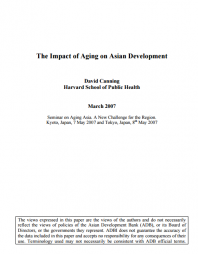
The Impact of Aging on Asian Development

Summary
The timing, speed, and dynamics of ageing in Asia. The world is aging. A combination of longer life spans and low birth rates is producing a population distribution that is skewed towards the elderly. This phenomenon is well advanced in developed countries in the region such as Japan and Singapore, but is also occurring in developing countries. Low infant mortality rates have led to population surges in China and India, but rapid declines in fertility rates in China, and now in India are reducing youth dependency rates. Both China and India are enjoying a “demographic dividend” of low overall dependency rates. In the foreseeable future, however, the current work force will age, producing a high old age dependency rate.
In the world as a whole, falling fertility and low youth dependency has dominated age structure changes over the last 50 years. However dependency rates reached their minimum in 2005. Since then arising old age dependency has led to increases in total dependency rates. While the basic structure of the picture is the same worldwide the timing and amplitude of the age structure effects differs greatly across countries. Within China and India there is a great deal of regional variation with inland regions lagging behind in terms of timing. A common feature however is for longer life spans and falling fertility to spread to developing countries while their levels of income are still very low. Countries therefore face the prospect of population aging at low levels of income.
An important feature of population aging is the compression of morbidity. In developed countries, the period of sickness and disability near the end of life is falling, even as life spans are increasing; we are producing a new generation of healthy old people. This makes the economic prospects of population aging much less troublesome than if the aging were unhealthy. An important issue in developing countries in Asia is if aging in a low income setting will be similarly healthy.
- Issues:
- Health, Demography, Urbanization and Migration
- Region:
- Asia
- Year Published:
- 2007
- Author:
- David Canning
- Institution:
- Asian Development Bank Institute (ADBInstitute)

